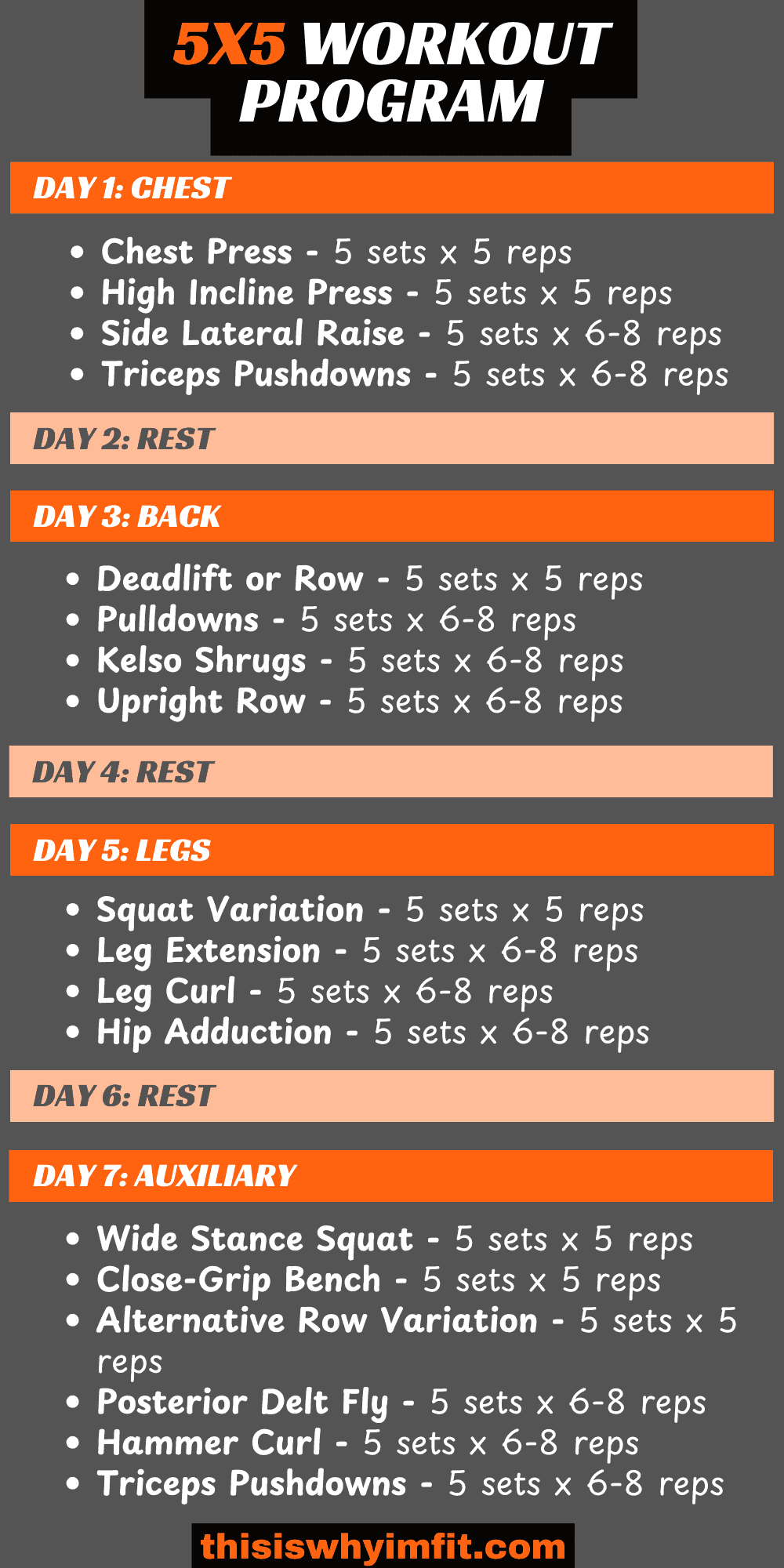
The best online fitness resource you'll ever need. We filter out the BS to ensure you meet your health and fitness goals!

The best online fitness resource you'll ever need. We filter out the BS to ensure you meet your health and fitness goals!

If you’re curious about stepping up your gym game or just tired of aimlessly wandering between machines, let me introduce you to our 5×5 workout program. It’s your new best friend in the weight room, designed to make you stronger and build muscle without any fuss.
Crafted for simplicity and effectiveness, this 4-day per week program focuses on big lifts that get big results.
Whether you’re new to the gym or just looking to get serious with your training, this routine cuts through the noise and lays out everything on a silver platter—well, a very heavy silver platter!
The 5×5 workout program sticks to a straightforward approach: 5 sets of 5 reps on key compound exercises. You’ll add weight, see progress, and maybe even start to enjoy the sweet, sweet symphony of clanking weights.
Jump to the 5×5 workout program now!
Alternatively, you can download the free PDF version of the program using the link below:
| Program style | 5×5 Resistance training |
| Workout duration | 2 hours |
| Scheduling | 3 days a week |
| Goal | Strength gains |
| Level | Beginners to advanced |
| Target Gender | Male and Female |
The 5×5 routine has been around for a long time.
Reg Park, Arnold’s inspiration to begin bodybuilding, was famous for following the 5×5 protocol back in the 1950s and 60s, winning the Mr. Universe title in ‘51, ‘58, and ‘65.

Like his mentee Arnold, Park went on to star in movies, playing Hercules several times.
So, it’s safe to conclude that the 5×5 routine has been around a while and has been proven effective in an era when steroids were not in widespread use.
The 5×5 has several advantages, and of course, a couple of drawbacks. What doesn’t?
The 5×5 weight training program works because it applies solid time-tested principles of building muscle.
One, the rep scheme is in line with what the exercise science literature now documents as most effective.
The geeks can talk all day about why this lower rep count makes best use of Henneman’s size principle, which says in summary that the muscles you want to grow need significant-enough load, and you need to impose that load before fatigue sets in. Ergo, fewer reps, and heavy.
Second, progressive overload. Once sets of 5 can be performed with good form during a workout, lift heavier the next.
Finally, it’s easy to remember and apply. The 5×5 couldn’t be much easier to follow. Super simple.
This doesn’t mean the routine itself is easy: the rep scheme and workout-to-workout method leaves little room for messing up.
Well, “con”, singular. Meaning there are more positives than negatives.
Rigid rep scheme. If the 5×5 has an Achilles Heel, this is it. And it’s a big one.
Muscles can’t do math. A stimulating, muscle-building set might end at 4 reps. It might end at 6. The science now suggests that the last couple of reps for a set that goes to task failure are the ones that work.
A successful set might only be 3 reps; Chris Beardsley’s stimulating reps model suggests it can be.
If you’re selecting weight that requires you to go to 5 reps, you may not be getting max stimulation in that week’s workout.
For some fun, scientific reading, check out this link.
In summary, the downside of 5×5 is only if you pick a weight that guarantees you’ll reach 5 reps. A 4-rep set can induce muscle hypertrophy and contribute to strength also.
It’s far superior to pick a weight where you miss the heavy sets of 5 this week, but get stronger and crush it next week. Hope this makes sense.
A traditional 5×5 workout program is designed to train 3 big lifts: squat, bench, and deadlift.
Workouts follow a straight sets format. Lift the same weight for 5 sets of 5 reps. If successful, increase the weight on the next workout.
Rules are made to be broken. And that’s a good thing with the 5×5.
Squat, bench, and deadlift mandatory? Says who? Same weight for 5 straight sets? Says who?
Can’t you pick 3, maybe 4, exercises that deserve focus, and apply a 5×5 format? What about using sets 1 through 3 to work up to really intense sets 4 and 5?
You CAN do those things and that’s what you’ll see in this routine.
The traditionalists argue that 5 sets of the same weight on those Big 3 lifts are the path to size and strength. As muscle-building practice has evolved, so has the science.
A 5×5 still makes sense but benefits with a tweak or 2.
This program is a 4-day program. Of those, 3 are “heavy” days for each of the target exercises and body parts.
The 4th is an auxiliary day that includes exercises to support the 3 you’ve selected.
The rest day application is up to you. You can alternate days, one-on-one off (which obviously doesn’t follow a calendar week). Or, you can do all 4 in a row with 3 days off if that works for you.
Side note: Being sore isn’t the goal here. If an exercise is new to you, there is a good chance you’ll be sore from it a day or 2 later. This will probably not last if you’re spacing your workouts wisely.
Here’s an example weekly schedule you can apply:
| Day | Split |
|---|---|
| 1 | Chest |
| 2 | REST |
| 3 | Back |
| 4 | REST |
| 5 | Legs |
| 6 | REST |
| 7 | Auxiliary |
You’ll notice right away some exercises where the rep schemes are as you’d expect: 5 reps. Those are done first in the workout.
The 5-rep exercises are followed by a few select exercises with a 6 to 8 reps-per-set scheme. These are isolation–usually single joint–exercises intended to supplement the “big” exercises. For instance, triceps extensions isolate the triceps that will help your chest press as you progress.
Here’s an example, using Chest Day.
| Chest Press | 5 | 5 | 5 | 5 | 5 |
| High Incline Press | 5 | 5 | 5 | 5 | 5 |
| Side Lateral Raise | 6-8 | 6-8 | 6-8 | 6-8 | 6-8 |
| Tricep Pushdowns | 6-8 | 6-8 | 6-8 | 6-8 | 6-8 |
Note that I’ve included a flat press variation, and an incline one. This has worked for me. Thought I’d share. Some may find this is too much work and leads to overtraining (aka outrunning your gains). If that’s you, just be honest with yourself and pick just 1.
Focus exercises with the 5-rep target are:
Supplemental exercises like curls and side laterals are prescribed at slightly higher rep ranges. Why?
Fatigue. The 5-rep 0 – 1 RIR reps are very taxing. The slightly higher rep schemes at 0 – 1 RIR require relatively lighter weight to achieve the rep count. They still create fatigue, but by comparison, they are less taxing than the “big” lifts.
A 5×5 routine doesn’t just mean that all exercises within the routine get 5 x 5. Reg Park’s didn’t. Just the focus “big” exercises.
If you wanted to, you could perform the supplemental lifts at 5 reps. Monitor your recovery. If your lifts go up week by week, fine.
Chances are, fatigue will catch up. But don’t let us stand in your way. Just be conscious of the concepts.
Two working sets plus 3 to 5 minutes’ rest require about 8 to 12 minutes per exercise. Rushing is counterproductive.
The first 3 sets of each exercise should be considered warm-ups. Budget a minute or 2 to rest between those sets.
Add it up and you’ve got as much as 17–maybe even 20–minutes per exercise. Think of it as an investment.
Already stated, this is a 4-day program.
The 5×5 reo scheme can be broadly applied. Don’t feel obligated to train only the Big 3.
Diversify if you like, or if those lifts don’t work for you. The only time you have to do the Big 3 is if you’re a powerlifter: they’re part of the sport.
For starters, pick a chest press, a back exercise, and a squat variation.
Your chest press could be on a machine. Deadlift isn’t a requirement for back. Hey, your squat variation could be a split squat like the Bulgarian.
What matters is that you select an exercise that gives you room to grow. It should be a stable exercise that allows you to focus on the muscles you’re trying to work.
The more stable an exercise is, the more you’ll be able to dial in on the target body part.
In general, a machine is going to allow you to do this more than free weights.
Use your brain and pick exercises that work for you and that you enjoy training. I’ve provided some options in the specified routine below.
| Exercise | Equipment Options | Rep scheme |
|---|---|---|
| Chest Press | Smith Machine, Chest Press Machine, Barbell, Dumbbells | 5×5 |
| High Incline Press | Smith Machine, Chest Press Machine, Barbell, Dumbbells | 5×5 |
| Side Lateral Raise | Cables (cuffs preferred), Dumbbells, Side Lateral Machine | 6-8 x 5 |
| Triceps Pushdowns | Seated Triceps Machine, Cable Machine (straight, EZ Curl, or V Bar) | 6-8 x 5 |
| Exercise | Equipment Options | Rep scheme |
|---|---|---|
| Deadlift OR Row | Barbell, Trap Bar, Seated Row Machine | 5×5 |
| Pulldowns | Cables (shoulder width or wider), Pulldown Machine | 6-8 x 5 |
| Kelso Shrugs | Smith Machine, T-Bar Row Machine | 6-8 x 5 |
| Upright Row | Cable Machine, Barbell, Dumbbells | 6-8 x 5 |
| Exercise | Equipment Options | Rep scheme |
|---|---|---|
| Squat Variation OR Leg Press | Barbell, Leg Press Machine (Pendulum, Belt Squat, Hack, Leg Sled) | 5×5 |
| Leg Extension | Leg Extension Machine | 6-8 x 5 |
| Leg Curl | Leg Curl Machine (seated preferred) | 6-8 x 5 |
| Hip Adduction | Hip Adduction Machine, Cables with Ankle Cuff | 6-8 x 5 |
| Exercise | Equipment Options | Rep scheme |
|---|---|---|
| Wide Stance Squat OR Sumo Deadlift | Belt Squat, Barbell, Leg Press (assumes wide-enough platform) | 5×5 |
| Close-Grip Bench | Smith Machine, Chest Press Machine (that has narrow grip option), Barbell | 5×5 |
| Alternative Row Variation | T-Bar Row Machine, Seated Row Machine (with chest support), Pulldowns (see above) | 5×5 |
| Posterior Delt Fly | Cable Machine (unilateral or both arms, cuffs recommended), Posterior Fly Machine | 6-8 x 5 |
| Hammer Curl | Cable Machine (rope attachment), Dumbbells | 6-8 x 5 |
| Triceps Pushdowns | Seated Triceps Machine, Cable Machine (attachment of choice) | 6-8 x 5 |

Progressive Overload. Your goal should be increasing the weight each week, although that’s not always realistic. Lifting more each week is very achievable for beginners due to the newbie gains phenomenon. The more experienced you are, the slower the gains
Reps in Reserve. Leave several reps “in the tank” for your first 2 sets. These are considered warm-up sets. The last set or two should be to failure or almost. The last rep or two of the last set will be moving very slowly no matter how hard you’re working.
Rest periods. Rest 1 to 2 minutes between your warm-up sets. Rest 3 to 5 minutes between your 2 heavy sets where you’ll lift your target weight for that session.
Warm up smart. Warm up for sure. Just don’t waste energy unnecessarily that you’ll need for your focus lifts. The first 3 sets of each focus lift are intended as a stair step to your 2 working sets. Use them wisely.
Stay hydrated. Drink plenty of water prior to your workout. How will you know? Urine will be almost completely clear.
Sleep. If you’re getting into the gym a lot you’ll need to stay in bed a lot too. 8 hours minimum nightly of good quality sleep.
Our 5×5 workout program is for people who are serious about building bigger, stronger muscles, who can set aside a couple of hours to train on workout days.
You’ll need that time to do the program as-written.
No.
As with any intense lifting regimen, overtraining is a real risk. Symptoms of overtraining include:
– Joint or muscle pain that doesn’t go away. (No, it is not weakness leaving your body. SMH.)
– Lifting less this week than last week, and next week doesn’t get any better.
– Interrupted sleep where sleep wasn’t previously an issue.
– Loss of desire to train.
– Irritability in the absence of other explanations.
– Catching a cold that lingers.
This is not an all-inclusive list. They’re symptoms I’ve experienced myself.
Progressive Overload alone gives clues to diagnose a plateau. When the poundages stop going up for several weeks at a time. The 5×5 is self-regulating in this regard. If the 5th rep seems out of reach for weeks on end, back off the weight enough to allow a 0 to 1 RIR for your 4th and 5th reps. If your diet and sleep are dialed in, the gains will come again.
I researched the 5×5 to provide a good, balanced routine with some basis in science and experience. Credit to the late Charles Poliquin whose work I researched, and the lifting historians who document how Reg Park trained. Already credited is Chris Beardsley. Thanks also to Paul Carter whose publications have been super helpful to me.
Download our 5×5 Workout Program PDF below:
We write custom programs. If you have specific physique goals–such as “I’d like wider shoulders”, or “I’d like more ‘V’ in my back”–we can write one for you. Reply in the Comments or simply contact us and we’ll get back in touch. First come, first served.